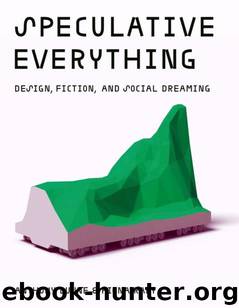Speculative Everything: Design, Fiction, and Social Dreaming by Anthony Dunne;Fiona Raby

Author:Anthony Dunne;Fiona Raby [Raby, Anthony Dunne;Fiona]
Language: eng
Format: epub
Published: 2013-12-12T00:56:00+00:00
Dunne & Raby, All the Robots, 2007, from the project Technological Dreams No. 1: Robots, 2007. Photograph by Per Tingleff.
Tommaso Lanza, Shredders, 2009, from the series Playgrounds /Toys. 0 Tommaso Lanza/The Workers Ltd.
Tommaso Lanza, Shoe, 2009, from the series Playgrounds/Toys. 0 Tommaso Lanza/The Workers Ltd.
Sputniko, Menstruation Machine, 2010. Photograph by Rai Royal.
DESIGN FICTION
Speculative design overlaps with several other emerging design approaches but design fiction is probably the closest, and the terms are often used interchangeably. It is a vaguely defined space where speculative, fictional, and imaginary design all collide and fuse. Although there are obvious similarities, we think there are some important differences. Bruce Sterling defines design fiction as "the deliberate use of diegetic13 prototypes to suspend disbelief about change ,,,14 which could also describe a precursor of design fiction sometimes referred to as "artifacts from the future." As it is popularly understood, design fiction is a narrower genre. It has grown out of the technology industry, and as the "fiction" part of the label references science fiction rather than general fiction, it places a strong emphasis on technological futures. Because of this, design fiction is increasingly being understood as a genre of future vision video (sometimes photos but rarely stand-alone objects) designed specifically for circulation on the Internet rather than in exhibitions. Another variation is Brian David Johnson's idea of sci-fi prototyping, which is a more applied version that focuses specifically on using fiction to quickly explore implications for technology in workshops. 15 Inevitably, design fiction suffers from some of the issues associated with film props mentioned at the beginning of this chapter, namely, a dependence on referencing the already known. We are more interested in using fictional designs to suggest things can be very different indeed, consequently our fictions are glitchy, strange, disruptive, and hint at other places, times, and values.
We do of course still use film and photography but rather than using them to ground the designs in "reality" or designing specifically for video, we prefer to use them to extend the imaginative possibilities of the physical prop, adding more layers and opening up more possibilities. Video and photography are secondary media. The physical prop is the starting point for a chain reaction developed through other media rather than a reality anchor for the video.
Like Margaret Atwood's preference for the term speculative literature over science fiction, we prefer the term speculative design over design fiction. Although, strictly speaking, we produce fictional designs, they have a broader purpose than the design fiction genre allows. Another difference that separates design fictions from the kind of fictional design we are interested in is that they are rarely critical of technological progress and border on celebration rather than questioning.
Download
This site does not store any files on its server. We only index and link to content provided by other sites. Please contact the content providers to delete copyright contents if any and email us, we'll remove relevant links or contents immediately.
POP by Steven Heller(3308)
Japanese Design by Patricia J. Graham(3110)
The Power of Broke by Daymond John(2898)
Architecture 101 by Nicole Bridge(2765)
Indistractable: How to Control Your Attention and Choose Your Life by Nir Eyal(2335)
Fusion 360 for Makers by Lydia Sloan Cline(2308)
Actionable Gamification: Beyond Points, Badges, and Leaderboards by Yu-kai Chou(2125)
Batik by Rudolf Smend(2124)
Origami Art by Michael G. Lafosse & Richard L. Alexander(2065)
Homebody by Joanna Gaines(2033)
Whiskey in a Teacup by Reese Witherspoon(1936)
Worn in New York by Emily Spivack(1927)
Feng Shui by Stephen Skinner(1903)
Austin Kleon by Steal Like an Artist(1889)
Simple Gatherings by Melissa Michaels(1857)
Don't Make Me Think, Revisited: A Common Sense Approach to Web Usability by Steve Krug(1826)
Hygge: The Danish Art of Happiness by Marie Tourell Søderberg(1694)
The Joy of Hygge by Jonny Jackson(1687)
The Laws of Simplicity by John Maeda(1568)
